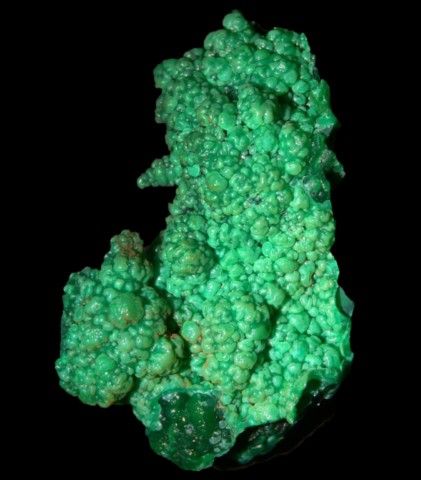GARNIERITE
Class : -
Subclass : -
Crystal system : -
Chemistry : -
Rarity : Uncommon
Garnierite is a general term designating a nickel ore composed of different hydrated nickel silicates and which owes its name to the French Mining Engineer Jules Garnier. These nickel silicates are formed during surface alteration at the expense of peridotites and dunites, rocks without expressed nickel minerals but composed mainly of orthorhombic pyroxenes and olivines which contain respectively 0.5% NiO and 0.6% NiO. The process of surface alteration destroys these minerals and enriches the emerging lateritic crust with nickel where this metal integrates the crystal lattice of newly formed hydrated silicates : garnierites.
Newly formed garnierites are either clay minerals, notably nickel saponites, or serpentines. Garnierite is also a term sometimes wrongly attributed to a serpentine with the formula (Ni,Mg)3(Si2O5)(OH)4. More strictly, these are nickel-bearing varieties of chrysotile or antigorite, or nepouite, which is a true nickel-bearing mineral of the serpentine group.
The term "noumeite" (in allusion to Nouméa and the very important lateritic nickel deposits of New Caledonia) is sometimes used to designate particularly rich garnierites, grading between 10 and 30% nickel.
Garnierite constitutes compact to powdery masses, with a talcose feel, of a beautiful characteristic apple green color. Intimate mixing with iron oxides can, however, result in a brown to painted ore tinged with greenish. It is an essential mineral, at least as important in terms of production as nickel from sulphide deposits. Polished can also be used in jewelry.
Main photo : Garnierite from the Camp des Sapins Mine, New Caledonia, France © Cédrick Gineste
Garnierite in the World
Fakes and treatments
No fakes recorded for this mineral species.
Hardness : 2 to 2.5
Density : 3.24
Fracture : Irregular
Streak : White-green
TP : Translucent to opaque
RI : 1.576 to 1.650
Birefringence : 0.027
Optical character : Biaxial -
Pleochroism : Low
Fluorescence : None
Solubility : -
Magnetism : None
Radioactivity : None


